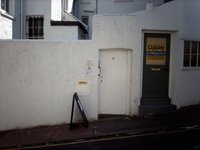MARCEL MOIA - A redrafted interview.
Daniel Pryde-Jarman, Daedalus
In response to the invitation to submit work on the theme of an ‘Extenuating Circumstance’ a piece that involved creating an artwork in front of a live audience at the show’s Private View was undertaken. Was this a performance?
No not a performance, rather a carrying out of a performative set of ‘gestures’ - without spotlight, fanfare or otherwise set aside platform. This extension to a series of works collectively titled ‘Analogue Pixellated Portraits’ was the first to be carried out in the presence of an audience. As ‘error’ is one of the concerns of the work, it was deemed interesting what potential differences the Extenuating Circumstance of a busy Private View might affect.
No one was spoken to during the act of making the work, even though they tried to engage in dialogue, was this because of a desire not to compromise what seemed to be a performative ritual?
The ‘conjuring’ of the work takes the form of a systematically ascetic ritual. According to this apophatic way the removal of everything irrelevant to the task at hand - the sticking of pieces of paper to the wall according to a predefined code, as fast as possible - is removed. Any altered-for-consumer deviation from this path would be the equivalent of say a Native American Ghost Dance performed for tourists – nothing more than a spectacle, empty of meaning.
The work was left after 2 hours because this was the original remit of the work’s design, but is it imaginable that a point could have been reached at which it would have been unacceptable to leave the work? Is completing an image like this in a given time an accomplishment or an arbitrary occurrence?
Usually these works are drawn directly onto the gallery wall, as a non-stop unseen performance-related aktion in 12-16 hours overnight, between the end of a Private View and the opening of the show the first day. The resolution of a chosen image – downgraded to a certain number of ‘pixels’ – is dictated by the area that it is guesstimated can be covered in the time available. The amount of work necessary is calculated to require high output for successful completion of the portrait, by a slim margin, but also at the same time encompass a real chance of ‘failure’. As this was the first trial of this methodology, which required the additional step of pre-sticking 2,500 small pieces of whitetack to the wall in a 50x50 grid, the time needed to complete was somewhat underestimated.
Should the image chosen this time, a kind of reproduction of Warhol’s screentest of Marcel Duchamp, be seen as a protracted portrait, or a perpetuation of visual art’s icon tradition?
The controlled but ‘frantic’ method of creation necessary seemed to set up an interesting dialogue with Duchamp’s unblinking and impassive sitting for the camera – surely a knowing minimal performance – in 1966. Whilst the elongation of the portrait, due to the squares of paper overlapping because the whitetack was mistakenly gridded too tightly, was completely unplanned, the iconoclasm of an iconoclast was fully intended – as error is always an anticipated and inevitable part of these portraits.
The ephemeral nature of the materials used - torn squares of paper - adds to the play between the laborious work ethic and the worth of the object left in the gallery, which has the dichotomy of being seemingly monumentalized and transient. Perhaps what was left in the gallery was a vestige of the act?
It is intended that the work makes apparent both its process and materials. The nature of the materials used being as unremarkable as possible, biro – pencil - kiddie crayon – cartridge paper, and the process of ‘hashing in’ and sticking up 2,500 small pieces of paper being so unspecial skilled as possible, hopefully draw attention to other interpretations of worth. What was left should be regarded as no more than evidence of something having happened… which is then later cleared away and ceases to exist.
The gallery was revisited near the end of the show to continue working on the incomplete image left behind after the Private View. To what extent was this return to the piece equivalent to prior incarnations? Was it comparable, or removed like a kind of tourism?
This was a departure from usual methodology, where works are completed as one continuous endurance feat. As the work is comprised equally of: the coding process, the actualization process, and the physically realised ‘object’, in this instance a work was not actually created. This incomplete work could be looked upon as similar to the fully carved but uninstalled heads (Moia) still in situ in quarries on Easter Island. The further working of the piece at the later date was undertaken as nothing more than an exercise - out of sheer curiosity.
Jul 15, 2006
Subscribe to:
Post Comments (Atom)


No comments:
Post a Comment